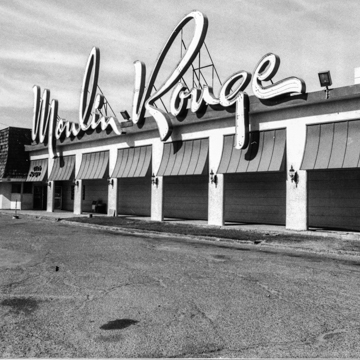The Moulin Rouge opened on May 24, 1955 as the first racially integrated hotel and casino in Nevada. Although it closed only five months later, the Moulin Rouge helped pave the way for integrated casinos and hotels. Before its opening, no casino in the state admitted African American patrons. Black entertainers performing at these casinos could not gamble or mingle with guests. Segregation forced them to find lodgings in rooming houses in the Westside.
Zick and Sharp of Las Vegas designed the one-story casino and theater attached to a two-story, V-shaped hotel to the west. The most striking features of the exterior are the four-story tower at the southeastern corner of the building and the giant “Moulin Rouge” sign mounted on the roof, in red neon script. Designed by neon artist Betty Willis, who later designed the Welcome to Las Vegas sign, the elegant looping French script was in the popular Googie style. The shingled mansard roofs on the casino and tower were added at a later date, most likely in the 1960s. The Moulin Rouge contains a large auditorium with a bar and murals depicting cancan dancers, fancy cars, and elegantly dressed people.
On the border between the black and white sections of town, the resort became famous for its “third show,” a program starting at 2:15 a.m. that featured entertainers from the Strip. Black and white performers, including Frank Sinatra, Dean Martin, Harry Belafonte, Louis Armstrong, and Sammy Davis, Jr., appeared onstage together or attended shows at the Moulin Rouge.
IN 1960, the Moulin Rouge was the site of the historic meeting that effectively ended segregation in Las Vegas. Black Las Vegans had threated to stage a protest march in the city against segregation in the city's casinos. Instead, in March 1960, days before the protest, the closed Moulin Rouge hosted a meeting between NAACP branch president Dr. James McMillan, Nevada Gov. Grant Sawyer, and the casino executives. The gaming bosses agreed to end segregation at that meeting, and McMillan then sent the Mayor, Oran Gragson, a letter giving him 30 days to desegregate the city. On March 26, 1960, a second meeting was held at the Moulin Rouge that included black leaders, the mayor, the police chief, and the governor, and they declared the casinos would be integrated that day.
The Moulin Rouge suffered a series of bad fires, and most of the buildings had deteriorated so badly that they had to be demolished. The casino sign was removed in 2009 and is now on display in the Neon Museum. Several proposals to reuse the site have been advanced, but so far none have been successful.
References
Clemons, Marvin. "Moulin Rouge Played Important Role in Las Vegas History." Las Vegas Review-Journal (October 24, 2019). Accessed June 29, 2020.
Weis, Derek. "Betty Willis: Neon Sign Artist." Neon Museum blog. (March 24, 2020.) Accessed June 29, 2020.
https://www.neonmuseum.org/the-collection/blog/betty-willis-neon-sign-artist.














